|
Dates:25 October, 2008~
The excavation of Tomb M1001 in Xibeigang was one of the most important discoveries of the fifteen excavations that the Institute of History and Philology (IHP) carried out in Anyang. This enormous royal burial was cross-shaped with four ramps containing more human sacrifices and artifacts than in all other royal burials in Xibeigang. Repeatedly looted and damaged, its original features were beyond recognition. Fortunately, through intensive scientific excavations, archaeologists were able to reconstruct its structure and formation. In addition, the recovery of an astonishing array of exquisitely produced artifacts from looters’ pits provided an unprecedented glimpse of the accomplishments of the Shang civilization. Among all the artifacts unearthed, the marble sculptures have received the highest praise. These include a kneeling anthropomorphic figure with tiger head and claws, a standing owl figure with decorative patterns covering its body, and a remarkable sculpture in the shape of two crouching tigers. Since the IHP began archaeological excavations at the Ruins of Yin during the 1930s, these marble sculptures have become iconic of Shang civilization and artwork.
At present, eight four-ramp tombs, three two-ramp tombs, and one single-ramp tomb have been excavated at the royal cemetery at Xibeigang. The discovery of Tomb M. 1001 was a monumental event, even though we may not be able to determine the time period or the identity of the tomb occupant. In addition to reflecting the material culture and the technological achievements of the time, it also reveals the development of a Bronze Age civilization, the resources owned by the King, the scope of the Shang state, and even the nature of the Shang kingship.
When the Sino-Japanese War broke out in 1937, the Institute was compelled to cease the excavation of the Yin Ruins in Anyang; and the Institute was relocated, along with Academia Sinica, several times. Thanks to the archaeologists’ constant care and protection, artifacts and field records from Tomb M1001 and other archaeological sites finally found a permanent home in Taiwan after years of continual relocation. Beginning in 1967, the artifacts from Tomb M1001 were on display in the National Palace Museum and were only returned to the Institute of History and Philology in 2000, not in time to be included in the permanent exhibitions for the reopening of the Museum of the Institute of History and Philology in 2002. It is to commemorate the 80th anniversary of the excavation in Anyang that these precious artifacts once again appear before the general public through this special exhibition.
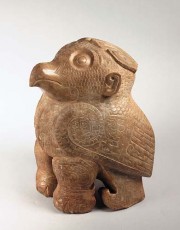
|
Sculpture of a standing owl, with vertical slot on the back Marble
Resource Identifier:R001756
Resource Type:Marble
Description:This standing owl is one of the finest marble pieces found at Anyang. The owl is vividly depicted with a pointy beak, round eyes and thick arched brows and covered with various decorations. On its back a long groove runs from head to tail, and it may have been designed for use as architectural ornamentation. The owl is often represented in Shang art, with examples in bronzes and jades. The decorations on this piece are similar to those found on its bronze counterparts.
Format:Height34.1、Length25.2、Diameter24.8cm,Weight24.3kg
Coverage:Fill of looters’ pit, Xibeigang Tomb No. 1001 |
| |
|
| |
|

|
Sculpture of a kneeling anthropomorphic figure with tiger head and claws, with vertical slot on the back
Resource Identifier:R001757
Resource Type:Marble
Description:This anthropomorphic figure with a tiger head, translucent and finely carved, is the finest example of marble sculpture from Anyang. With head slightly tilted upwards, mouth agape and teeth bared, the figure crouches, claw-like hands placed on its knees. The sculpture is covered with incised decorations that include dragons with bottle-horns on its arms, and vertical dragons with curved tails from its thighs to hip. Its underside is divided in two, and a vertical groove runs along its back, possibly for attaching it as an architectural ornament.
Format:Height37.1、Length21.4、Diameter26.8cm,Weight28.5kg
Coverage:Fill of looters’ pit, Xibeigang Tomb No. 1001 |
| |
|
| |
|
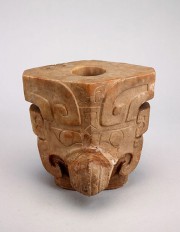
|
Pole ornaments with two owl heads on opposing sides
Resource Identifier:R005055, R005056
Resource Type:Marble
Description:The pair of double-sided owl ornaments are the only examples of their kind from Anyang. The two pieces are identical in style, each with a beaked owl head on both the front and back sides. The owl’s plumage, ears, eyes and jaw are rendered in high relief, while its upper beak is rendered in openwork. A hole is found in the center of each piece, possibly used to attach the piece to poles or shafts.
Format:Height18.9、Area of Tabletop13.5×21.4, Area of Tablebase13.5×21.4、Hole diameter5.5cm,Weight7.9kg
Coverage:Fill of looters’ pit, Xibeigang Tomb No. 1001 |
| |
|
| |
|

|
Sculpture in the shape of two crouching tigers
Resource Identifier:R001755
Resource Type:Marble
Description:A unique marble sculpture that shows two crouching animals joined at the hips. The sculpture weighs almost 100 kg, and its flat shape suggests it could have been used as a seat. Judging from the teeth, eyes, eyebrows, and claws, these animals may be representations of tigers. The protruding snouts and forelimbs of the animals form the two ends of the object; similar arrangements are also seen in the three inlaid wooden palettes found in the tomb (see adjacent wall for images of the slates). The sculpture is covered with carefully arranged decorations in low relief. On the side of each forelimb is a hole that leads to two grooves at the bottom of the sculpture. These features may have been designed for looping ropes around the object in order to lift it.
Format:Height2.7、Length84.7、Diameter41.2cm,Weight99.8kg
Coverage:Fill of looters’ pit, Xibeigang Tomb No. 1001 |
| |
|
| |
|
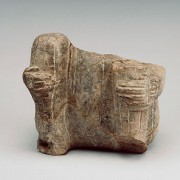
|
Fragment of a squatting human figure, with vertical slot on the back
Resource Identifier:R022116
Resource Type:Marble
Description:Unearthed from Daliankeng in the northern part of the temple-palace complex of Xiaotun, the figure is missing the parts above the chest and below the ankles. In a peculiar posture, the figure sits with legs apart and folded, held tightly against the chest by its hands, placed just beneath the knees. Swirling patterns adorn its arms and legs, with an animal mask motif in shallow engraved lines near the groin. A vertical slot runs along the back of the figure, making it similar to the standing owl and anthropomorphic figure with a tiger head from Tomb No. 1001 and possibly an architectural accessory.
Format:Height8.6、Length12.0、Diameter10.0cm,Weight1.6kg
Coverage:Trench Daliankeng, Xiaotun |
| |
|
| |
|

|
Fragments of a robed and kneeling human figure
Resource Identifier:R001580
Resource Type:Marble
Description:One of the few examples in Shang art of representations of humans. The figure, crouching with hands on knees, bears carved patterns on its front and sides that represent clothing: a right-lapelled robe, fastened near the waist with a wide belt bearing swirl patterns, with the sleeve rims, lapel edge, and lower rim of the robe also decorated with swirls. The figure is pieced together with fragments from Tomb No. 1004 and 1217, indicating that the two tombs were looted at the same time.
Format:Height12.7、Length7.5、Diameter9.8cm,Weight after repair1.2kg
Coverage:Fill of looters’ pit, Xibeigang Tombs No. 1004 and No. 1217 |
| |
|
| |
|

|
Figure of a standing owl
Resource Identifier:R001610
Resource Type:Marble
Description:Vividly depicted and finely crafted, this standing owl is one of the masterpieces of marble sculpture unearthed at Anyang. It is covered with intricate patterns from head to tail, including dragons on the sides of its head, symmetrical bird patterns on its chest, and insect patterns on its back. Incised patterns adorn the front of its talons, with dragon patterns on the sides.
Format:Height17.1、Length10.6、Diameter9.1cm,Weight after repair2.5kg
Coverage:Fill of looters’ pit, Xibeigang Tomb No. 1001 |
| |
|
| |
|

|
Tiger、Buffalo、Dragon
Resource Identifier:R014450:1、R014450:2、R014451:1、R014451:2、R014452:1、R014452:2
Resource Type:Marble
Description:The six sculptures, comprised of dragons, buffalos, and tigers in pairs, were found in the south ramp of Tomb No. 1500, untouched by looters. They were arranged into two rows, all facing north, with the dragons at the front, the buffalos in the middle, and the tigers at the end. With relatively simple rendering of the shape and shallow engraved lines for the features and limbs, these sculptures are less elaborate than the sculptures from Tomb No. 1001.
Format:Height13.4、Length29.8、Diameter10.1cm,Weight6.0kg、Height13.9、Length28.3、Diameter11.7cm,Weight8.4kg、Height15.5、Length41.0、Diameter14.0cm,Weight15.0kg
Coverage:South ramp, Xibeigang Tomb No. 1500 |
| |
|
| |
|

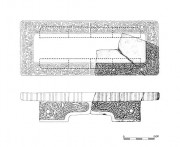
|
Fragment of a stone table
Resource Identifier:R005034
Resource Type:Marble
Description:Although only one fourth of it has survived, this is one of the most elaborate stone tables unearthed at Anyang. An array of tigers decorates the edges of the table top, and a dragon with coiled tail occupies the front of the remaining stand. Decorations are executed in low relief.
Format:Height9.3、 Area of Tabletop9.6×14.0、Thickness of foot3.3cm,Weight2.3kg
Coverage:Fill of looters’ pit, Xibeigang Tomb No. 1001 |
| |
|
| |
|
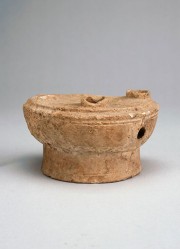
|
Pigment container with four round compartments
Resource Identifier:R007512
Resource Type:Marble
Description:Several similar examples of such vessels have been unearthed at Anyang; materials used range from bronze and marble, to pottery. Residues of different colors are often found in the round compartments, hence the term pigment container. The hole on the side of the vessel may be for attaching a handle.
Format:Height7.6、Diamete12.6、Diameter of foot9.5cm,Weight1.4kg
Coverage:Fill of looters’ pit, Xibeigang Tomb No. 1001 |
| |
|
| |
|

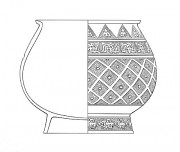
|
Sherds of lei vessels
Resource Identifier:R000145、R024950、R024951 、R024952、R024956
Resource Type:Pottery
Description:These sherds are from multiple vessels with almost identical shapes and decorations. Most parts of the vessel are represented, but not complete enough for restoration. Reconstruction by archaeologists indicates that the vessel has a low, bulging belly and a ring-foot. Decoration is carefully executed, with triangular cicada patterns under the rim, dragon motifs on the shoulder, and square patterns on the vessel body.
Coverage:Fill of looters’ pit, Xibeigang Tomb No. 1001 |
| |
|
| |
|

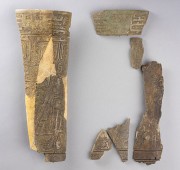
|
Fragments of carved bone beakers
Resource Identifier:R004134、R004135、R004137
Coverage:Fill of looters’pit, Xibeigang Tomb No. 1001 |
| |
|
| |
|
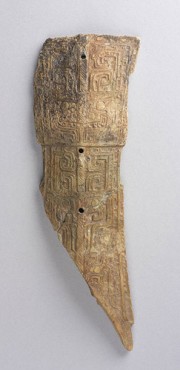 |
Whistle with carved animal-mask motifs
Resource Identifier:R004581
Resource Type:Bone
Format:Length17.3、Width8.5、Thickness2.1cm,Weight105.8g
Coverage:Fill of looters’ pit, Xibeigang Tomb No. 1001 |
| |
|
| |
|

|
Bone object with carved lizard motifs
Resource Identifier:R004586
Format:Length28.0、Width11.6、Thickness1.3cm,Weight158.5g
Coverage:Fill of looters’ pit, Xibeigang Tomb No. 1001 |
| |
|
| |
|
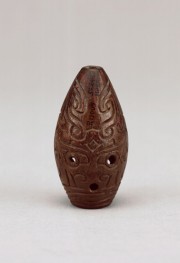
|
Whistle with carved animal-mask motif
Resource Type:Bone
Format:Length5.3、Diameter1.6-2.8,Weight19.8g
Coverage:Fill of looters’ pit, Xibeigang Tomb No. 1001 |
| |
|
| |
|
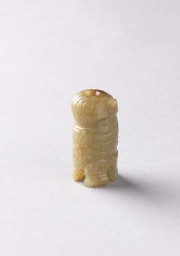
|
Owl
Resource Identifier:R001293
Resource Type:Jade
Format:Length3.4、Diameter1.7、Hole diameter0.4-0.6cm,Weight18.0g
Coverage:Fill of looters’ pit, Xibeigang Tomb No. 1001 |
| |
|
| |
|
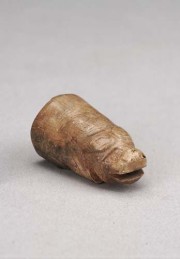
|
Buffalo
Resource Identifier:R001292
Resource Type:Jade
Format:Length3.9、Diameter2.2,Weight28.1g
Coverage:Fill of looters’ pit, Xibeigang Tomb No. 1001 |
| |
|
| |
|
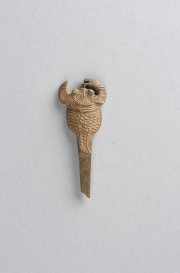
|
Hairpin with scorpion
Resource Identifier:R004001
Resource Type:Bone
Format:Length5.8、Diameter2.3、Thickness0.8,Weight5.0g
Coverage:Fill of looters’ pit, Xibeigang Tomb No. 1001 |
| |
|
| |
|

|
Shell ornaments in the shope of animal head
Resource Identifier:Roo3575.R003576
Resource Type:Ornaments
Format:Length4.0、Diameter3.3、Thickness0.7,Weight15.4g
Length3.2、Diameter3.4、Thickness0.7,Weight12.5g
Coverage:Fill of looters'pit, Xibeigang Tomb No. 1001 |
Text and images are provided by Institute of History and Philology, Academia Sinica
Digital Resources and Archived Images Application
|